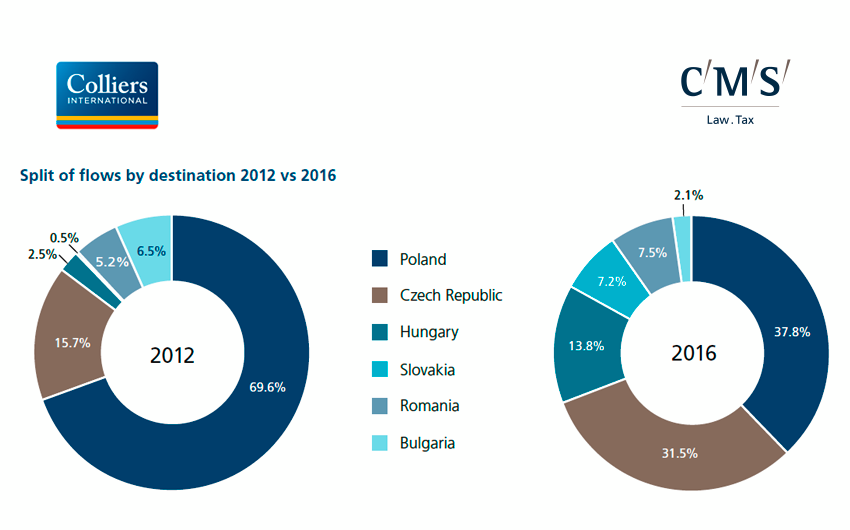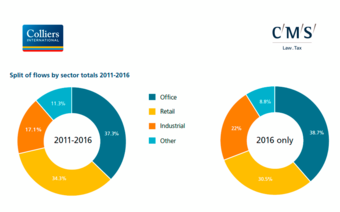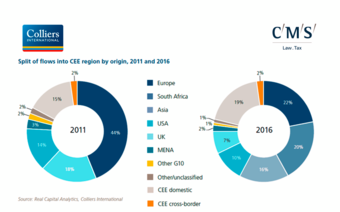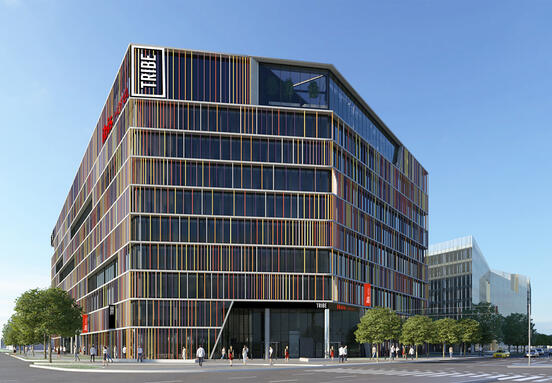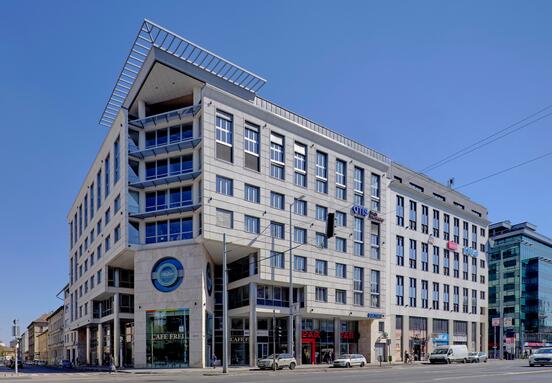The CEE Real Estate Investment Compass 2017 examines key trends in the real estate market in six Central Eastern European countries (Bulgaria, Czech Republic, Hungary, Poland, Slovakia and Romania) over the last five years, and takes a look at what is on the horizon for 2017.
In the first quarter of 2017, preliminary real estate investment in the CEE-6 markets stands at EUR 2.3bn, representing a 41% and 45% increase compared with Q1 2016 and Q1 2015 respectively.
Looking at trends in 2017 in the CEE, the increased returns via lower yields are predicted in Budapest and Bucharest (all 3 segments of real estate market: office, retail and industrial), Prague (in office and industrial) while in Bratislava (all sectors), Warsaw (industrial and retail) and Sofia (office and industrial) similar market situation is expected.
“The growing maturity of the CEE region may help combat the specific risks affecting Western Europe, that of “Brexit” and its reverberations, which may unfold further in 2017. Brexit’s full consequences are not yet known and some might even end up as a positive for CEE,” says Mark Robinson, senior researcher, CEE, Colliers.
Whereas Western Europe remained the main source of investment in the CEE real estate market last year, a marked shift took place in 2016 with South African, Asian and CEE investments surpassing those from the G10. 2017’s flows from these regions are predicted to continue this year, with Asian and domestic/CEE sources continuing to drive new investment in the region, the report reveals.
Large portfolio-type deals involving Asian investors may become more common in CEE’s real estate sector, resulting in deal values matching or even exceeding last year’s results, given the large number of potential capital sources. Interest from Asian investors in the region, particularly in Poland and Hungary, has grown considerably over the last three years, with total investments reaching EUR 2bn in 2016.
Cross-border and domestic flows have more than doubled in last five years, reaching EUR 2.6bn in 2016, a strong sign of maturity in the region. The Slovak and Czech markets were both the largest origins and destinations of CEE cross-border flow in 2011-16, while Hungary’s domestic flows have grown most rapidly in the recent period.
“The further distance we get from 1989, the more developed the CEE markets become and the less reliant on outside investors we are. This can be observed not only in the real estate sector, but in the whole M&A market,” says Wojciech Koczara, partner at CMS. “The spread of Warranty & Indemnity insurance across the CEE markets is another sign of growing maturity in the region as well as the increased level of sophistication in the structuring of large real estate deals”.
“2016 was a very busy year for our real estate group, as we had the opportunity to counsel on several high-profile real estate transactions. The first quarter report suggest this won't change in 2017 either, with Hungary and the Czech Republic being the most popular targets of investors” – said Gábor Czike, Head of Real Estate and Construction at CMS Budapest.
“The total investment activity in 2016 and the volume of completed deals in Q1 2017 drives the sense of optimism going ahead and 2017 may very well be the strongest year ever in the history of the Hungarian capital markets. The level of oversubscription of transactions and the improving pricing effect of strong commercial property fundamentals will be evidenced in the growing transaction volume. Further, we expect to register new markets entrants in 2017 and 2018.” – commented Bence Vecsey, Head of Investment Services at Colliers International Hungary.
Domestic investors are becoming increasingly comfortable with market liquidity, and with commercial real estate market capitalization estimated at between 55% - 65%, local investors such as those in Poland who only executed 2% of deals in their local market in 2016, may be tempted to become more active. The main risk to domestic activity in CEE in 2017 is a global economic slowdown, perhaps triggered by higher bond yields or China’s debt pile.
Source: CMS, Colliers International
